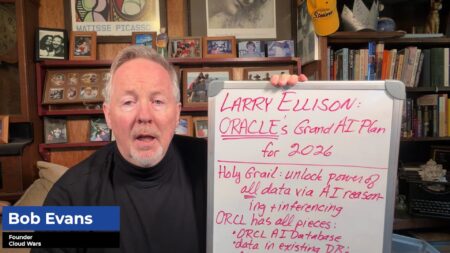Despite continued strong growth from its flagship HCM product line that’s the dominant player among the Fortune 500, Workday says its high-flying Financials business will become the company’s biggest revenue driver over the next several years.
That crossover event is still some ways down the road, but it’s highly significant. It clearly underscores Workday’s ability to become a broad-based supplier of enterprise applications. And it also points to a coming boom in the overall market for cloud financials and cloud ERP.
Workday CEO Aneel Bhusri, speaking on the company’s fiscal 2020 Q3 earnings call last week, compared Workday’s buildout of interrelated enterprise applications to a similar expansion effort that Salesforce undertook in its younger days.
Highlights from Workday’s Q3 Earnings Call
“Our financials business continues to grow at a rate north of 50%. And I think there’s durable growth in that business for many years to come,” Bhusri said on the earnings call.
“I would hope in five years that that business is on par or bigger than the HR business—it just takes time.
“And I would point you to the transition that Salesforce went through—they’re six years older than us and one of our very best partners. Salesforce went from being a sales company, to a sales and service company, to a sales and service and marketing company, and then they added platform and now they’ve got analytics,” Bhusri said.
“We’re going through that same journey. And growth rates kind of ebb and flow as the different pillars take off. So we’re very optimistic on what we continue to see as continuing growth in HR, but also very healthy growth rates in the office of the CFO.”
That growth in CFO-related markets is certainly something that has impacted rival Oracle. Chairman Larry Ellison has claimed that his company’s market share in the cloud ERP business is in the range of 95%.
So while we can split hairs over what constitutes “cloud ERP” versus “cloud Financials,” there’s no question that both Workday and Oracle are aggressively courting the CFO as a huge source of strategic and long-term growth.
How Workday Helps CFOs Learn to Love the Cloud
In Workday’s case, Bhusri said, the opportunity has expanded significantly as it has complemented its core Financials applications with new capabilities in analytics (its Prism Analytics apps) and planning (its Adaptive Insights line).
In fact, Bhusri went so far as to say that those two new areas have become the key drivers behind CFOs’ decisions to move to the cloud.
“Before planning and analytics really took off for Workday, we had a very competitive financial offering. And two key things were at play. One, the CFO market in general wasn’t ready to move to the cloud. And second, just having a next-generation accounting platform or financial platform was necessary but insufficient,” said Bhusri.
Then the Workday CEO delivered a killer insight into the buying decisions of CFOs here at the dawn of 2020.
“The areas of planning and analytics are really what drive CFO decisions today,” Bhusri said.
“And of course they also realize they need to modernize their accounting systems from a financial-transformation perspective”—but the essential triggers for the CFO are no longer what they used to be.
Can Workday Help CFOs Predict the Future?
In today’s data-driven world, those drivers are now deep capabilities to plan and model in a fast-changing world with planning apps, and to begin to predict the future with analytics tools driven by ML algorithms.
“So all of a sudden it’s not just ‘hey, we have to modernize it from a technology platform perspective,’ but instead it’s ‘look at all the benefits we get from a planning perspective, from an analytics perspective, and yes, even from a core accounting perspective what we can do in terms of machine learning, what we can do in terms of tagging so that you can create richer analytics,’” Bhusri said.
And those trends, he said, are intensifying.
“All those now come into play and the story is much stronger going into this year than it’s ever been.”
Closing Thought
The things that got us to today won’t take us where we need to go tomorrow. Workday offers two perfect examples of that. First, that the product lineup that rocketed the company to prominence—HCM—will be surpassed in the future by a complementary product line (Financials) with a larger TAM. And second, that high-flying Financials business is no longer just about “financials” but about forward-looking and data-intensive analytics and planning capabilities.
In the Cloud Wars, things move at a dizzying pace—so don’t get too comfortable out there.
RECOMMENDED READING
Exclusive 1:1 with Aneel Bhusri: Machine Learning Changes Everything
SAP Says HCM Is Dead—Can Qualtrics Transform it to HXM?
Workday Faces 3 Key Questions as $4-Billion Run Rate Looms
Archrivals Oracle and Workday Agree on One Thing: SaaS Market Booming
Machine Learning More Disruptive than Cloud, Says Workday CEO Aneel Bhusri
Disclosure: at the time of this writing, Workday was a client of Cloud Wars Media LLC.
Subscribe to the Cloud Wars Newsletter for in-depth analysis of the major cloud vendors from the perspective of business customers. It’s free, it’s exclusive, and it’s great!








